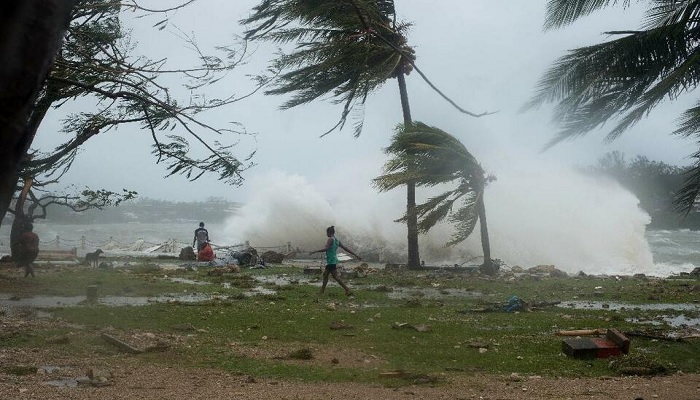Major disaster feared as mighty Mocha cyclone crashes on Myanmar coast
Mocha will “completely cross” southeastern Bangladesh’s Cox’s Bazar, where the world’s largest refugee camp is located
With winds as strong as a category 5 Atlantic hurricane, mighty Cyclone Mocha crashed on Myanmar’s west coast on Sunday with its destructive power putting millions of unsheltered people in its way in grave danger amid warnings that a major disaster and a subsequent humanitarian crisis was in the making.
The tropical cyclone, which formed in the Bay of Bengal early Thursday has gathered a lot of momentum, with sustained winds of 259 kilometres per hour (161 mph) and gusts of up to 315 kph (195 mph), according to the Joint Typhoon Warning Center on Sunday.
According to Bangladesh Meteorological Department, Mocha is likely to move north-northeasterly across Rakhine State in Myanmar and “completely cross” southeastern Bangladesh’s Cox’s Bazar, where the world’s largest refugee camp is located.
"Our camp houses, which are constructed with bamboo and tarpaulins, can be blown away in soft, light winds," Mohammad Sayed, 28, told AFP from Nayapara refugee camp in Bangladesh.
"The schools, which are designated as cyclone shelters... are not strong shelters that can withstand the winds of a cyclone. We are scared."
"The wind is getting stronger at the moment," rescue worker Kyaw Kyaw Khaing told AFP earlier from Myanmar's Pauktaw, about 25 kilometres inland from Sittwe, where he said around 3,000 people had arrived to seek shelter.
"We distributed enough food for one or two meals to the people evacuated to temporary shelters. I don't think we will be able to send any food today due to the weather."
Thousands left Sittwe on Saturday, packing into trucks, cars and tuk-tuks and heading for higher ground inland as meteorologists warned of a storm surge of up to 3.5 metres (11 feet).
A media account run by junta authorities in Rakhine showed what it said were trees downed over a road near Sittwe.
"We are not OK because we didn't bring food and other things to cook," said Maung Win, 57, who spent the night in a shelter in Kyauktaw town. "We can only wait to get food from people's donations."
Bangladeshi authorities moved 190,000 people in Cox's Bazar and nearly 100,000 in Chittagong to safety, divisional commissioner Aminur Rahman told AFP late Saturday.
The rain and wind were felt in Myanmar's commercial hub Yangon, around 500 kilometres away, residents said Sunday.
'Major emergency'
The Myanmar Red Cross Society said it was "preparing for a major emergency response".
In Bangladesh, authorities have banned Rohingya refugees from constructing concrete homes, fearing it may incentivise them to settle permanently rather than return to Myanmar, which they fled five years ago following a brutal military crackdown.
The camps are generally slightly inland, but most of them are built on hillsides, exposing them to the threat of landslides.
Forecasters expect the cyclone to bring a deluge of rain, which can trigger landslips.
"The wind started about 8:30 this morning and it's getting stronger," a Rohingya community leader in a displacement camp in Myanmar's Kyaukphyu told AFP.
"A house at the camp collapsed and the roof of a shelter built by UNHCR was blown away," they said, requesting anonymity.
Hundreds of people also fled Bangladesh's Saint Martin's island, a local resort area right in the storm's path, with thousands more moving to cyclone shelters on the coral outcrop.
Those left behind said they feared the storm's approach.
"We are in a panic because we don't have enough cyclone shelters here," Jahangir Sarwar, 23, a resident of Saint Martin's told AFP by phone.
"We asked the administrators many times that everyone should be evacuated to a safe place in mainland Teknaf town. But no action was taken."
Cyclone Mocha is the most powerful storm to hit Bangladesh since Cyclone Sidr, Azizur Rahman, the head of Bangladesh's Meteorological Department, told AFP.
Sidr hit Bangladesh's southern coast in November 2007, killing more than 3,000 people and causing billions of dollars in damage.
Operations were suspended at Bangladesh's largest seaport, Chittagong, with boat transport and fishing also halted.
Cyclones — the equivalent of hurricanes in the North Atlantic or typhoons in the Northwest Pacific — are a regular and deadly menace on the coast of the northern Indian Ocean where tens of millions of people live.
In 2008 Cyclone Nargis devastated Myanmar's Irrawaddy Delta, killing at least 138,000 people.
Scientists have warned that storms are becoming more potent as the world gets warmer because of climate change.
-
Queens mother arrested after abducting child from court-ordered visit
-
Kentucky grandmother arrested after toddlers with broken skulls, ribs
-
Cheaper cars, fewer EVs: Trump administration shifts ‘auto policy’ focus
-
European leaders slam Trump’s tariff threat over Greenland as ‘unacceptable’
-
Nova Scotia snow storm warning issued as heavy snow moves in
-
Trump warns of new tariffs for countries opposed to Greenland takeover
-
Global cooperation on deathwatch: UN chief warns of ‘powerful forces’ in play
-
Insurrection Act in Minneapolis? Trump says 'not right now'












